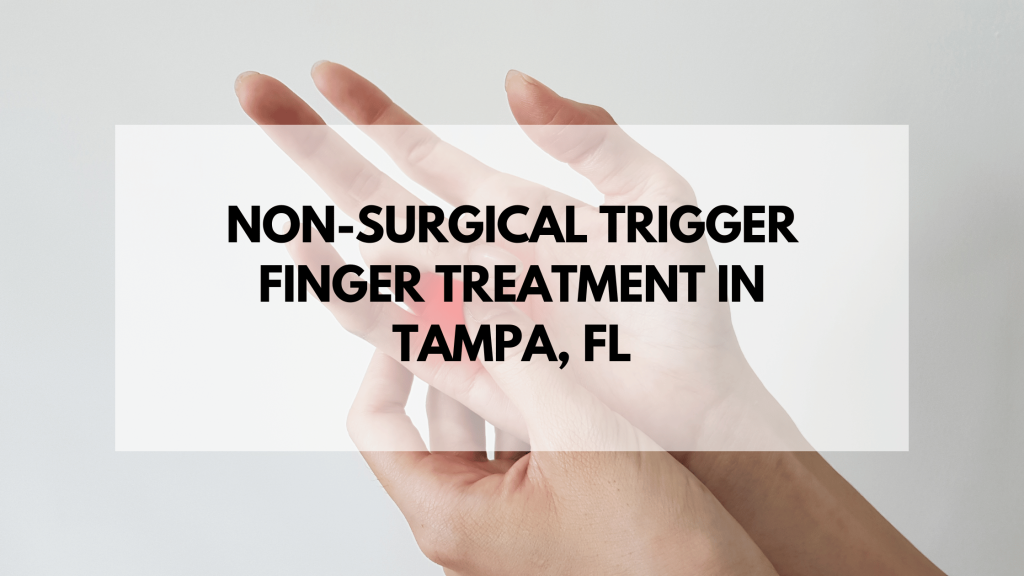Trigger finger can be an annoying and limiting condition, causing pain and discomfort when you try to bend or straighten your fingers. But now there is a new non-surgical treatment available at our clinic in Tampa, FL that can help alleviate the symptoms of trigger finger without the need for surgery! Come find out how we can help you get back to living life with free movement in your hands.
What is trigger finger or trigger thumb?
Trigger finger is a condition characterized by clicking or locking of the finger / thumb during when you’re bending your finger. Catching of the tendon can occur due to inflammation or swelling of the tendon or the fibrous bands (“pulleys”) that hold the tendons close to the bone. The most common site of triggering occurs at the A1 pulley.
Check out this picture to see where the A1 pulley is located.

- *Picture taken from PMID: 17099099
What Are Tendons?
Tendons are the rope-like extension of muscles. They slide in a well-defined channel and attach to a bone to cause joint motion. There are specific sites along the course of a tendon where it is restrained by pulleys to prevent it from “bow stringing.”
What Are Pulleys?
Pulleys are tight bands beneath which the flexor tendons must glide. There is a sheath in between the pulley and the tendon itself. This is a very thin, hollow tube constituting a self-lubricating system.
What causes trigger finger?
Doctors aren’t really sure what causes the tendon or sheath inflammation that may lead to trigger finger. But there are some common conditions that often accompany trigger finger:
- Diabetes
- Gout
- Arthritis (osteo / rheumatoid)
- Dupuytren’s contracture
The underlying similarities between these conditions is that they all involve underlying systemic inflammation in the body.
How is trigger finger traditionally treated?
- Rest from activities that worsen symptoms
- Splinting at night
- Stretching exercises
- NSAIDs (advil, aleve, tylenol)
- Steroid/Cortisone injections
Surgical Treatment Option (OPEN SURGERY)
- Incision is made over the A1 pulley to cut and release the A1 pulley blocking tendon movement
- Typically performed in an outpatient surgery setting
What are the success rates of traditional treatment options for Trigger Finger / Trigger Thumb?
According to The Efficacy of Steroid Injection in the Treatment of Trigger Finger published in 2012, the success rates of cortisone injections is relatively low. 1 injection has a success rate of around 30% and the success rate after 3 injections is just over 60%.
Open surgery success rates for trigger finger approach over 95% but this involves surgery a scar and a longer recovery period.
The problem is with cortisone is that there is a high failure rate and the injection itself is fairly painful. There are also problems that happen when cortisone injections are repeatedly given – it causes tendons and ligaments to weaken. Over time this can lead to arthritis and degeneration in the adjacent joints.
Surgery has it’s own risks. One it’s surgery, so there is a scar and multiple layers have to be cut open. This can lead to infections and problems down the road. Second surgery is expensive compared to non-surgical options.
If you’ve had a cortisone injection and it didn’t work, then it’s time to consider a non-surgical, non-invasive option for trigger finger.
The good news is there is a new non-invasive, non-surgical treatment option for Trigger Finger / Trigger Thumb
This is a new technique that Dr. Hanson, DACM has brought to America using a specialized needle that has been used in Korea for the last 50 years called an acupotomy needle. Dr Hanson, DACM has been using this technique for years and has an average success rate of 90% after 2 visits spaced 2 weeks apart.
Traditionally a similar technique was used using a hypodermic needle (one that you would get a shot with) but this had some problems – mainly the cutting edge of the hypodermic needle could cause additional damage and side effects.
With Dr. Hanson’s specialized non-surgical release technique these side effects are not a concern and the downtime is minimal. Most patients are back to their normal activities the next day and some even go on back to playing sports like golf the following day.
Benefits of Non-Surgical Trigger Point Release Performed by Dr. Hanson, DACM
- 90% success rate after 2 visits, spaced 2 weeks apart.
- Quick in office procedure – done is 5-10 minutes.
- All digits respond favorably.
- Return to activity in the follow 1-3 days.
- No scar.
- Relatively painless procedure, can be performed with or without numbing medication.
- No harsh medications like cortisone and none of the side effects like cortisone has.
The Good News
If you have trigger finger or trigger thumb there is a great non-surgical option that is inexpensive and very effective. Schedule a visit with Dr. Hanson, DACM to have your trigger finger assessed and treated in the same office visit today.


